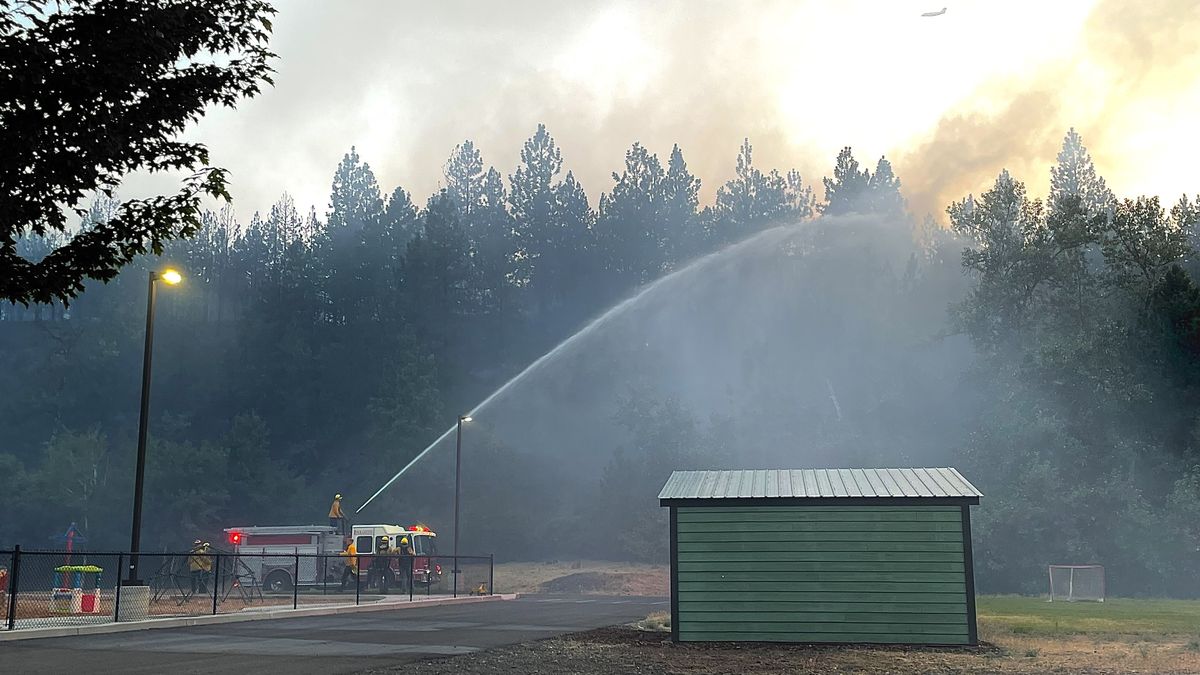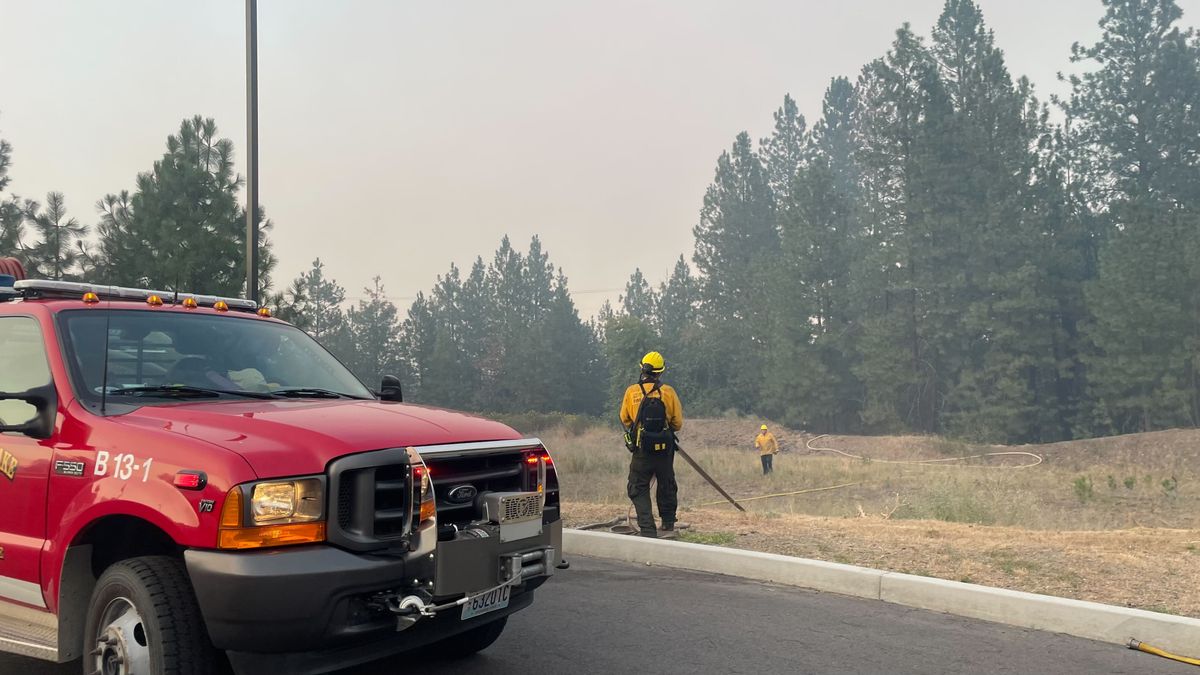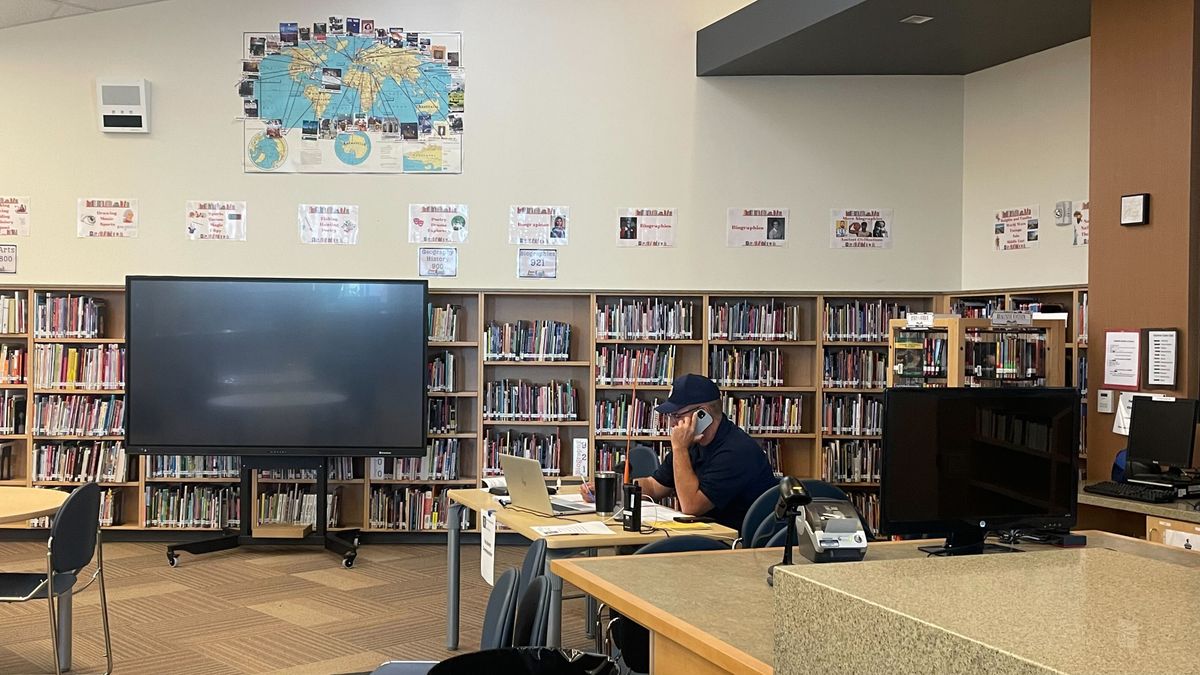‘When the fire bell rings’: Here’s how teams quickly mobilized to fight Spokane County’s two wildfires on Friday
Andrew Stenbeck sits at his makeshift desk at the Cheney Middle School library on Saturday, July 27. He is the incident commander for two Spokane County fires that sparked Friday. (Alexandra Duggan / The Spokesman-Review)
Cheney Middle School is normally crawling with kids – this time, it was full of firefighters and incident command staff who came together at a moment’s notice during two Spokane County wildfires on Friday.
The first fire that sparked south of Tyler near Columbia Basin Highway in the afternoon. Within hours, the fire had spread to nearly 300 acres, and multiple planes were circling with fire retardant and water.
Following immediate evacuations in Tyler, a second fire near Palisades Park, west of downtown Spokane, overtook 90 acres of forestry area. Crews stationed themselves behind Palisades Christian Academy with their engines to assist them in spraying water over the tops of the trees while flames almost approached the doorstep of the school.
In both fires, crews were actively communicating with one another. They were intently listening to radios, constantly hopping in and out of engines, pointing their fingers where a plume of black smoke would suddenly erupt. And none of them appeared to panic.
One firefighter walked out from behind the Christian school, covered in ash and dirt with a smile on his face. Another roped up an engine hose when his team finished putting out spot fires nearby, wiped the sweat off his forehead and lit a cigarette.
Like a well-oiled machine, everyone knows what to do, said Andrew Stenbeck, the East Uplands District manager for the Northeast Region of Washington State Department of Natural Resources.
Stenbeck sat in the Cheney Middle School library on Friday surrounded by papers, pens and computers. Below his makeshift desk, a paper sign read, “Incident Commander.”
“When the fire bell rings,” Stenbeck said, “I go.”
Asked if managing two fires at the same time is difficult, he shrugged.
“We’ve been doing this for a while.”
Stenbeck is part of a “Type-3” incident team. It’s not his day job, however. The team was called in by DNR and Spokane County Fire District 3, which determined after their initial attack of the fire that they needed to transition into an extended attack, which means fire crews won’t be able to mop up the fire in a 24-hour period. This takes more specialized resources for what is referred to as a “complex incident,” which is why the Type-3 teams were requested.
Typically, crews will begin digging a fire line to stop the spread of the fire with hand tools, maybe the size of a small hiking trail. But once the flames grow more than 4 feet tall, trying to dig a line and spray water gets much harder, Stenbeck said. A bulldozer can come in and dig a wider line, but sometimes it’s hard to even do that.
Aircraft come in when flames are 10-12 feet tall to reduce the size back down so firefighters can get closer, Stenbeck said. DNR spokesman Ryan Rodruck said District 3 ordered air attack right away.
So when Stenbeck got the phone call that there was a growing wildfire in Spokane County, he had his Type-3 team on the road within an hour.
People who are a part of the Type-3 teams typically specialize in areas associated with fire management during the day, but when they’re called into a wildfire, they go.
The middle school’s library had people set up inside for payroll and finances, safety, planning, operations, logistics and more. Portable restrooms were ordered, shower trailers were en route and some wildland firefighters were in the parking lot eating sandwiches nearby stacks of bottled water.
Jessica Walston, a DNR environmental planner, was one of the people called as part of the Type-3 team. This weekend, she assumed the role of a planning section chief instead.
Every decision made during a wildfire is logged, Walston said – such as where the aircraft will land, what equipment is available or how long an ambulance could take to get to the scene in case of a medical emergency. The weather and fire behavior is constantly being tracked in case anything changes. The area surrounding Tyler was surveyed for safety issues.
A pamphlet for the two fires used in planning tells firefighters to be aware of active railroad lines, unknown hazardous materials and power lines.
“Drive defensively … Treat all (power) lines as if they are live … Stay alert … Stay well clear of the RR tracks!!!” the pamphlet says.
“We are working really tightly with operations to meet the needs and the objectives on the line. For example, we just had a need for a structure engine,” Walston said. “When there is a need on the line, they relay it up to us, and we make it happen. We make it happen the right way, in a safe way.”
The Type-3 team got to Cheney in mere hours of the call, and most of them worked through the night. When the rest of the members woke up from their tents or cots at 6 a.m., they had their morning briefing where they decided how to divide up the teams going to each fire.
Teams are able to communicate effectively, Rodruck said, because each incident is given a specific number through the Northeast Washington Interagency Communication Center in Colville. Then, each individual resource responding to the fire gets its own number.
“Usually, the incident commander will say, ‘Hey, I need this specific thing.’ They have someone in rotation, and then the center calls and says, ‘Here’s the location you need to report to and the person you need to report to,’ ” he said.
Teams also must know which channels to listen to – the average person might see a firefighter constantly reaching to the radio behind his back, twisting and turning the knob to listen to multiple channels that are all running at once.
One is a main channel, one is for dispatch, one goes to aircraft, which are flying above and coordinating with people below about what they see, Rodruck said. Other channels can go from engine to engine, which is just one example of how everyone works as one cohesive team.
“As much as we want to hope our day job ends, it never does,” Walston said. “We’ll meet our rest ratio by taking naps today … But we work long, hard hours.”


